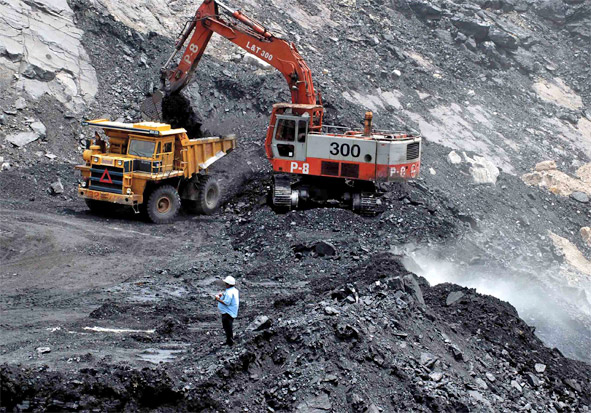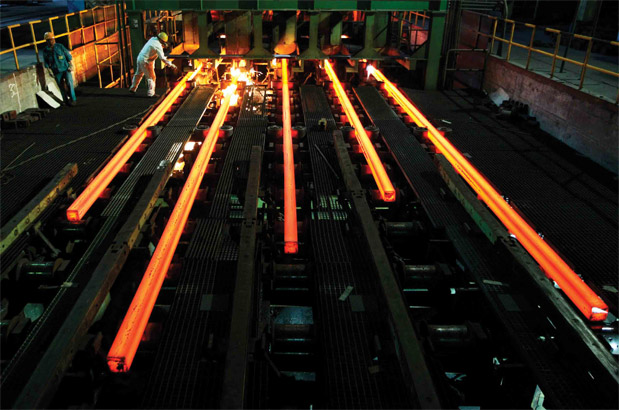DOMESTIC steel industry is still recovering from the last years’ global slump in the sector followed by largescale dumping in India, particularly from China. Short-term measures, such as imposition of anti-dumping duty on cheap imports, did provide some respite to the Indian industry. Still steel companies account for little less than 20 per cent of the total non-performing assets (NPAs).
Thankfully, country’s economic engine is running fast as India is one of the fastest growing economies. The Modi government is making efforts to accelerate it further by focusing on infrastructure creation, which has a direct bearing on the domestic steel sector. Indian steel sector has grown rapidly to become the third largest producer after China and Japan. It also holds the same global rank in terms of consumption. Country’s sustained economic growth makes it a lucrative market for global steel giants, hence there is an urgent need to strengthen domestic steel companies and make them competitive.
The industry is of strategic importance to India as it is the backbone of key industrial sectors—construction, infrastructure, power, engineering, automobile and consumer products. The sector contributes about 2 per cent of the country’s GDP and employs over 5 lakh people directly and about 20 lakh people indirectly.
Realising its strategic importance for the Indian economy, the government recently announced the New Steel Policy (NSP) 2017. Although it seeks to give impetus to the steel sector by addressing both demand and supply issues, it repeats some key issues enumerated in NPS 2005 that hampered competitiveness of Indian steel companies vis-à-vis their global rivals.
A similar policy document was prepared 12 years ago (NSP 2005). It had pointed at six key impediments that required urgent policy intervention—mining issues, coking coal import dependence, low R&D investments, high cost of debt, inadequate infrastructure and low productivity. Even after 12 years of policy intervention the domestic steel sector is still facing these challenges. The government needs to recalibrate strategies in NPS 2017 to “adequately” address these issues. It is appreciable that NSP 2017 is a flexible document that can be amended depending upon the experience gained during implementation and market dynamics.
The Ambition
IN 2015, when steel consumption in China, Japan and USA registered negative growth, India consumed 5.3 per cent more steel than the previous year. In 2016, India retained its position as the fastest growing major steel economy in the world. Now it plans to almost double the capacity to 300 million tonnes (mt).
NPS 2017 projects crude steel capacity of 300 mt, production of 255 mt and a robust finished steel per capita consumption of 158 kg by 2030-31. The key features aim for development of globally competitive steel manufacturing capabilities—cost-efficient production as well as domestic availability of iron ore, coking coal and natural gas.
Under this policy, the Steel Ministry has committed to ensure availability of raw materials like iron ore, coking coal and non-coking coal, natural gas, etc., at competitive rates through policy measures. However, the policy needs to go much further if it really aims to achieve its stated objectives within the time frame.
The Oversight
The ambitious capacity addition programme would not take off in a vacuum. It must be synchronised with similarly robust demand. Who will dare to invest in creating capacity if existing facilities are under-utilised? One of the biggest policy triggers should have been on improving demand for steel. The NSP 2017 is also leveraging upon the government’s ambitious plans like ‘Housing for All’ and ‘Make in India’ campaigns. There is speculation that the government may make it mandatory for local projects to buy local steel. While these are welcome initiatives, it cannot be a long-term solution because of being protectionist in nature. As demand is always associated with price, steel demand in India can have a boost only if the country can have good quality steel at affordable prices.

If the Central government really wants raw material to be available at competitive price, it should rationalise the tax and duty structure on iron ore and coking coal which can substantially reduce the cost of raw material for the domestic steel producers
Competency
It is a point to ponder that countries like Japan and Korea, and to great extent China, who are dependent on imported iron ore and coking coal, can sell cheap but quality steel products to India. This is mainly because of abysmally low level of investment in R&D by our steel producers, which is less than 0.5 per cent of sales as compared to 1-1.5 per cent by the Japanese and Korean steel makers.
Although Steel Development Fund (SDF) was set up long back in 1997-98, the progress is not very encouraging. Out of 91 projects, only 55 projects have been completed, 24 projects are in progress and 12 have stopped as of March 31, 2016. While the Indian steel companies are getting so many safeguards from the Government of India in terms of trade protection and other schemes, it is imperative that the domestic steel makers take necessary steps to increase expenditure in R&D to improve their competitiveness, reduce cost and improve product mix through innovation.
It is a pity that more than 150 mt of unsold iron ore has been lying as stockpile in different parts of India. Most of this is less than 62 per cent Fe grade. This is because the domestic steel mills prefers only high grade iron ore and reject low-priced lower grade material. On the other hand, Chinese steel mills can consume iron ore with Fe content as low as 56 per cent. Why can’t our steel mills use such low grade ore in their steel making process? The government should ensure investment in innovation for using low grade ore, which is abundantly available in India, to maximise Value in Use for the BF Mix in the steel plants and simultaneously develop high end steel products to reduce dependency on costly imports.
Raw Material Cost
TO make steel affordable and to revive the steel industry it is necessary to supply raw materials like iron ore and coking coal at cheaper price. Raw material will become cheaper only when its supply will be augmented. However, iron ore miners are frequently under criticism for the reason of high cost of production to the Indian steel makers. But the fact is that iron ore only accounts for 18-20 per cent of the total cost while it is the coking coal which is responsible for 30-40 per cent of the total cost.
India has over 18 Bt of proved reserves and 34 Bt of total resources of coking coal. However, inadequate washing capacity and lack of exploration have increased India’s dependency on imports. India cannot afford million tonnes of high quality coking coal to keep burning under Jharia decade after decade and instead import, draining national exchequer. The government must take serious note on Jharia Action Plan and foster exploration of coking coal in a massive way with simultaneously encouraging setting up coal washeries.

Similarly, augmenting the iron ore supply, particularly in States like Karnataka where iron ore production has been capped, can further reduce the cost of iron ore. Undue government control over pricing and availability of raw materials has been one of the reasons behind Indian steel industry losing competitiveness, both in terms of quality and pricing. Affordability cannot be achieved by a mere price control mechanism/formula of raw material, rather than by easing the hindrances of supply.
We can take a cue from the coal sector reforms. Let us look at what was done to ease the prices of coal and power to make it affordable as an example. As per a government report, India will double its coal production to 1.5 billion tonnes by 2020. This massive supply of coal will, in turn, reduce the prices of coal sourced by the power and other sectors as it seems to have already done in the global market of coal. The Indian power sector is no longer at the mercy of imports for coal and, in fact, the Indian coal industry is also looking for export avenues.
A similar model can be replicated in the Indian iron ore industry if only regulatory restrictions on the capacities of the iron ore mines are removed. Karnataka, a mineral rich State, can be a crucible of domestic supply for the steel mills in the region without having to source ore from other far reaching states like Odisha and countries like South Africa and Brazil, incurring heavy expenditure on transportation and shelling out a high price for ore.
Tax Burdens on Raw Material
In a market where end product is freely determined, it is imperative that the raw material prices should also be determined freely based on demand and supply factors, without any government intervention. However, in India the key raw material of steel-making—iron ore and coking coal—are highly taxed, which in turn increases the cost of steel production. Iron ore mining industry in India is already paying a royalty of 15 per cent of sale price, which is one of the highest in the world. This is further inflated after accounting for DMF and NMET charges, which are directly linked with royalty at the rate of 30 per cent and 2 per cent of royalty, respectively. Then there are State level taxes, like SPV fund in Karnataka and Goa Permanent Fund in Goa, at 10 per cent of sale price, which are mostly similar to DMF.
IN a subdued iron ore market, this leaves hardly anything in the hands of domestic miners to spend on productivity and efficiency to reduce cost of mining. Any attempt to control price of domestically produced iron ore is also a retrograde step for the iron ore mining industry, which is already crippled with various challenges.
Coking coal, which is produced in small quantity and largely imported to meet domestic demand, is taxed at 2.5 per cent Import duty for an unknown logic. This, coupled with the Rs. 400 per tonne of Clean Energy Cess, imposes a substantial burden on the coal cost for steel companies. The cumulative cost of these taxes on raw material is approximately Rs. 2,000 per tonne (based on the fluctuating prices), almost equal to the conversion cost of RM to Hot metal in a blast furnace. These taxes are not permitted to be set-off even under GST, thereby doubling the effective cost of making steel from the raw material. Removal of these costs alone will turn around a number of steel companies in the red currently.
If the Central government really wants raw material to be available at competitive price, it should rationalise the tax and duty structure on iron ore and coking coal which can substantially reduce the cost of raw material for the domestic steel producers. Reduction of royalty on iron ore to 5-7 per cent (in line with Australia and South Africa), abolition of import duty and Clean Energy Cess on coking coal and the Central government closely working with State governments to remove duplicity in taxation can revive steel mills’ profitability.
Revisiting Policy Framework
India has competitive advantages in steel and the new policy recommendation to source raw material from secondary markets, such as scrap, will fritter the industry. By doing this, India will be throwing away the scope of creating employment opportunities, while impacting the environment and providing a route to any unregulated / hazardous scrap to find its way to our soil. With India being a mineral rich country having large reserves of iron ore, should we then be resorting to scrap as feed for the steel industry?
Before India envisages for 300 mt steel capacity, what will happen to the existing 122 mt capacity, large part of which are languishing for low utilisation and in serious debt trap? Before new capacity addition, the government should help the existing units to consolidate. These units should be turned around by merging ‘healthy’ players with required incentives so that it would be a ‘win-win’ situation for both. Financial institutions should be convinced and taken on board to encourage such consolidations. The government’s immediate focus has to be on improving capacity utilisation to the robust levels of 90 per cent.
Revitalisation
The government has tried helping distressed companies by raising the import duty on steel and slapping additional protective measures like MIP, safeguard duty, etc., but the fact remains that the bad loans of steel industry account for as much as Rs. 1.15 lakh crore as of November 2016, which is almost 2 per cent of India’s GDP. In terms of outstanding loans owed to banks, the industry saw the highest slippages at 7.8 per cent, followed by textiles at 6.4 per cent. Even State-run giant SAIL, known to be a highly profitable company, reported a net loss of Rs. 794.84 crore for the quarter ended December 31, 2016.
It is time therefore not to take a myopic view but have a technologically advanced and competitive steel industry. This can be brought about by inducing innovation and disinvestment in the steel sector, thereby saving it from meeting a fate like the public sector aviation service Air India.





























































